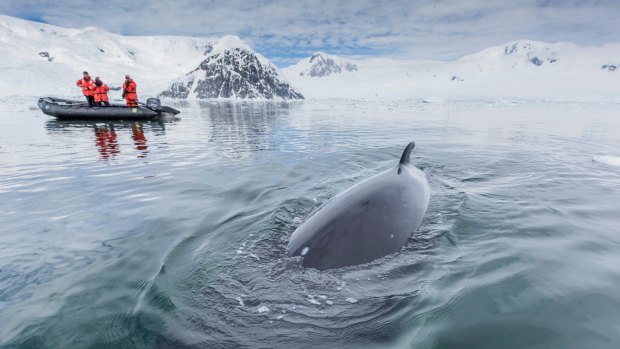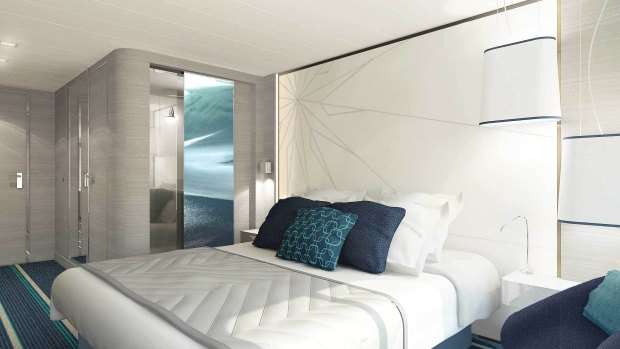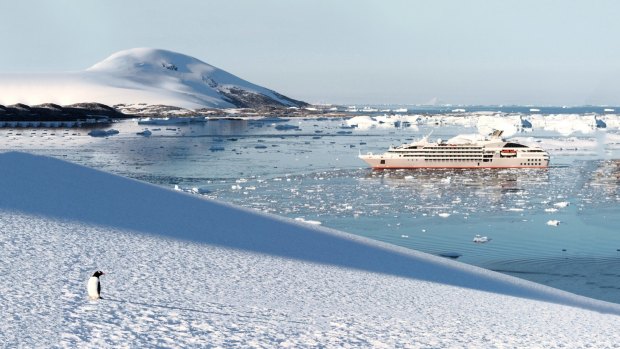This was published 5 years ago
Antarctica: The one trip nothing can prepare you for

A curious Antarctic minke whale (Balaenoptera bonaerensis) approaches a Zodiac in Neko Harbour, Antarctica.Credit: Alamy
Perhaps I was craving solitude more than I'd realised. But my first thought, just minutes after setting foot on the Antarctic continent is, you can leave me here. The pre-departure words of our expedition leader Florence Kuyper, "you've seen it in documentaries and photos before, but nothing can prepare you for the real thing", are ringing true. The first glimpse of penguins pushing their pudgy bodies past the surreal backdrop of glaciers and icebergs, the icy whip of wind on skin, the utter silence and serenity of this empty, unforgiving place – it's enough to make frosty fugitives of us all.
As my red parka-clad expedition companions and I start picking our way along a path marked with small orange flags to stop us stepping on a "penguin highway" etched into the snow, or a "penguin creche" where baby penguins gather, the landscape starts to reveal its lessons. A fuzzy infant penguin pecks my boot and I get misty-eyed over how rare it is to meet an animal completely unafraid of humans, because it hasn't yet learned not to be. A gigantic chunk of ice calves off a glacier, crashing into the sea with a sound like the end of time, and I'm reminded of the impermanence of all things.
The carefully placed flags eventually lead up a steep, snow-blanketed hill. I sit under the steely sky and drink in the magnificent views over Neko Harbour, our ship looming in the distance as a striking contemporary counterpoint. It's hard to believe this pristine glacier-flanked bay ever played host to anything as macabre as a floating whaling factory ship, as it did for many seasons between 1911 and 1924. Today, it is the picture of peaceful perfection, a haven where "penguins are the inhabitants, humans are the guests", as Kuyper told us shortly before we came ashore. It is a corner of the earth where, for the first time in a long time, I feel that things are in their right place.

A suite aboard Le Lyrial.
I would like to stay but, you know, it'll mean certain death if I do. And besides, there's warming broth and hot toddies awaiting onboard our Ponant APT-chartered ship Le Lyrial. After a shower and change in our plush cabins, it's time for a three-course a la carte lunch served in the dining room, before piling the layers on once again for the afternoon excursion.
Back in our Zodiacs, we whiz across the icy waters to Port Lockroy, where Kuyper worked as base leader a few years back for a season. As we disembark she tells us this picturesque cove, inhabited by hundreds of gentoo penguins and three infinitely Instagrammable black, white and red huts, started out as a base during World War II when the British were attempting to establish a permanent presence in Antarctica. Kuyper points out the cylindrical black and white Nissan Hut, which was the supplies store until the base closed in 1962. When Port Lockroy reopened in 2010, the Nissan Hut became accommodation for the handful of intrepid UK Heritage Trust volunteer staff who call this place home each summer season, while the original station hut Bransfield House is now a museum and souvenir shop.
This season five women are volunteering here, conserving the site, educating the 15 to 17,000 annual visitors, and running the southernmost souvenir shop in the world. It's here that I meet one of them, a woman in her mid-20s who, as she sells me a pair of penguin tea towels, I can't help but ask how she's been coping with the isolation. "Well," she says after a pause, "after a while you get what we call 'Antarctic Brain'; you start to go a bit mad." The isolation, the below-freezing temperatures, the lack of entertainment – it all starts to get to you, she says.

Ponant Le Lyrial is a striking contemporary counterpoint of the Antarctic landscape.
For Kuyper, however, her Port Lockroy stint was bliss: utter seclusion, and perfect peace. As we tiptoe carefully around the penguins back to our Zodiac, she turns to gaze wistfully at her old home. "We didn't have TV in there but we didn't need it, these penguins provided all the entertainment. It was heaven." She begins to walk away but I linger a few moments longer, fantasising again about how it might be to be left here, a contended castaway in a frosted nirvana.
Air New Zealand flies daily from Sydney and Melbourne to Buenos Aires via Auckland. From there it's a three-and-a-half-hour flight to Ushuaia, where ships depart for Antarctica. See airnewzealand.com.au
SAIL
APT's 15-day Classic Antarctica tour starts from $16,490 per person. See aptouring.com.au
Nina Karnikowski travelled as a guest of APT.
Sign up for the Traveller Deals newsletter
Get exclusive travel deals delivered straight to your inbox. Sign up now.